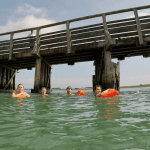River swimming in winter
First light. The Thames is flowing into London at about 400m3/s. That means nearly 1.5 million tons of water per hour are thundering over the weir at Teddington Lock. I watch the murky swirling waters for a few minutes, trying to gauge the speed from the ducks and seagulls drifting by. It’s somewhere between a fast walk and a slow jog — faster than I can swim. I check the depth of water at our usual exit point and make sure it’s not obstructed, and I measure the water temperature. It’s around 6 degrees Celsius. The wind is light and the clouds are breaking up. It’s a good morning for a swim.
I take off my jacket and trousers — I already have my trunks on — and pack them in a bag along with a towel, which I leave on the riverbank. I’m swimming with my friend Liz. It’s always good to have someone to swim with, especially in winter. We agree to try a longer swim today. In flip flops, and wearing only light tops, we walk a kilometre upstream. As it’s the middle of winter, and cold, we get quizzical looks from the runners and cyclists on the towpath.
It’s a 15-minute walk to where we want to get in. The road is flooded. We can’t see the edge. We had planned to launch into the water from a pontoon belonging to a local canoe club but it’s submerged and invisible. We remove our final layers, pack them into tow-floats and put on swimming hats and goggles. I have no intention of putting my face in the muddy water. I wear the goggles because they have prescription lenses and I like to see where I’m going.
I go first, shuffling towards the river, feeling for the edge of the road with my feet. It’s less than knee deep but I can’t see my toes. When I find the edge, I sit down. I slide forward on my bottom. I had expected to find the pontoon but I’d missed it and was immediately in deep water. It was lucky I’d sat down, otherwise I’d have fallen and possibly knocked my head. I warn Liz about the sudden drop and start swimming. The current catches us and sweeps us downstream, fast.
We head towards the middle where the current is strongest. It’s safer here, in deep water, away from the trees and other obstacles along the banks. In the first minute or so it takes me to adjust to the temperature and for my breathing to settle down, we’ve already drifted about 100m. This is a one-way journey. There’s no way to swim back to the start if you change your mind.
About two minutes in is the best part of the swim for me. I’m comfortable in the water and not yet cold. My fingers still function. I reach for my camera, which I’ve tied to my tow float, and turn to look upstream. Because the river meanders, this stretch heads northwest, which means I need to look back the way we’ve come to watch the sunrise.
The best sunrises are on clear frosty mornings when the water temperature is warmer than the air and you get a mist rising from the river. Ideally, you want a band of cloud a short distance above the horizon that gets lit up underneath by the sun. We had a string of these in the autumn, always on days when I didn’t have a camera with me. Today’s sunrise was pretty, as they all are, but wasn’t as spectacular as some we’ve seen. Still, the forecast had been for thick cloud and we were blessed with clear blue skies.
As we sweep downstream, we see other swimmers walking up. They wave and ask what it’s like. We say it’s lovely. We’re moving faster than the dog-walkers on the towpath and almost keeping up with the joggers, although we’re hardly swimming a stroke. I check the time. I’d estimated the swim would take about 10 minutes and I don’t want to be in the water longer than that at these temperatures. With 8 minutes gone, I start looking for the exit. Overshooting wouldn’t be a disaster as there is an alternative 200m further downstream, but I’d rather get out where we’d planned, and where my towel and warm clothes are waiting. The trick is to start swimming across the current while you are still upstream of the finish so that you move diagonally towards where you want to get out.
In the last few metres, I turn onto my back and drift in feet first, feeling for the riverbed. I climb out quickly. It’s time to focus. The sooner you get dressed, the sooner you can start warming up again. My fingers are numb, which makes unclipping my tow float tricky, and I usually waste a few seconds on this. I have a routine for post-swim dressing. I think most swimmers do. I dry myself roughly with the towel and put on my top layers first: thermal vest, long-sleeve t-shirt, fleece and down jacket. Only then do I remove my trunks and pull on trousers, socks and shoes. Finally, I put on a second coat, hat and gloves, and stick a hot water bottle between my legs. Winter swimming isn’t competitive but it is a race to get dressed after. Ideally, you want all your layers on before you start to shiver. It isn’t glamorous either. But it is fun, and something of a sanity saver during lockdown. In the UK, we’re still allowed to exercise with one other person from outside our household and I welcome the opportunity to chat briefly with Liz.
I know some people have been critical of river swimming this winter on social media, particularly when the Environment Agency has put up red boards and advised all boats not to use the river. I don’t, therefore, do this lightly or frivolously. While I know there are hazards, it is not as dangerous as some non-swimmers appear to believe it is, provided you pay attention and take standard winter swimming precautions (see https://outdoorswimmer.com/blogs/cold-water-swimming for more on this). In addition, you need to be aware of the additional hazards posed by fast-moving river water.
At school I used to kayak. The best trips were always in the winter when the rivers were flowing full and fast. It was more challenging than in the languid waters of summer, and often tested my skills in the rapids to their limits, resulting in many unwanted swimming experiences. But it was more satisfying. Swimming in winter is similarly rewarding. In August, the river temperature was 20 degrees and flow was less than 10m3/s — a factor of 40 less than today. The current was barely discernible. We had some delightful swims. We frequently stopped to chat, play on a rope swing or look for kingfishers. Winter swimming is different. Not so comfortable, but more exciting and demanding, and once you’ve warmed up again, you have a warm glow that lasts all day.









